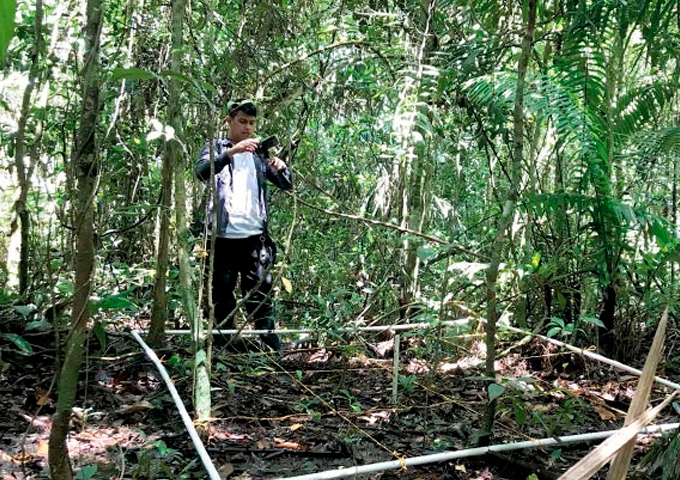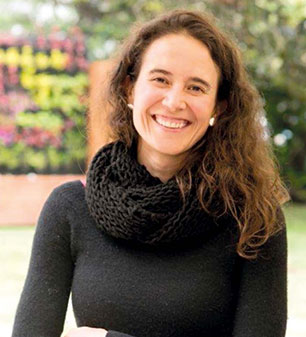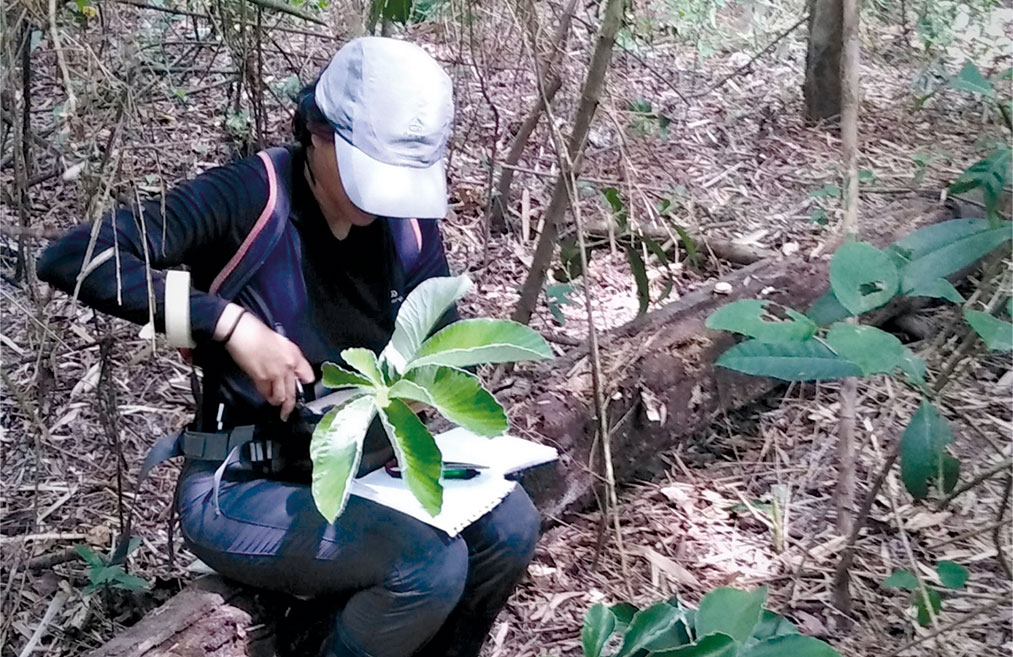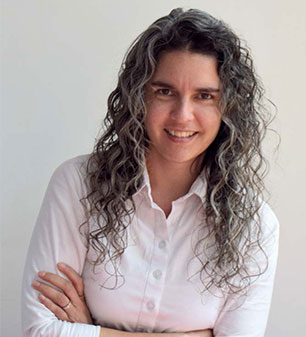A "scientific orchestra" with a shared baton
By: Lina María Leal Villamizar
Photos:
Science and Tech

By: Lina María Leal Villamizar
Photos:
"I do not deem my students as subordinates, but as my colleagues,” claims Adriana Sánchez Andrade, a coleader of the Incubator Ecology of Tropical Plants of the Faculty of Natural Sciences at Universidad del Rosario. For her, everybody has the intellectual skills; the difference lies in the experience.
Professor Sánchez Andrade is a researcher in Ecology. Over four years ago, she began to work on a part time basis in the incubator (then called Management for Preservation and Biodiversity of Ecosystems in Colombia), which was founded and run by Professor Francisco Escobedo, a well-known foreign researcher who worked at Universidad del Rosario on ecological systems and their relations with human beings between 2016 and 2020. Sánchez Andrade was progressively in charge of that formative research scenario, together with professor Ana María Aldana, who also studies issues in that field.
The researchers jointly decided to focus the name of this group on the exploration of tropical plants and starteda process of the reading and discussion of specialized articles in weekly meetings. However, Sánchez warns, with this method, “the students were very passive,” so they started changing roles to work with shared leadership, where the students also run and choose what to do. It is similar to an orchestra where the baton passes from hand to hand to conduct projects and interpret the best pieces collaboratively.
“I like to conceive the teacher’s role as a facilitator. We help seeking the resources, explain the methods, and support the processes, but it is the students who lead their projects and groups,” Adriana comments.
Since then, the students—whose number has ranged from 5 to 16—have taken the lead of this musical scientific orchestra, which, besides applying for research proposal calls, have managed to add other activities such as lectures, field trips, and seminars with external researchers, who give talks on their investigation and share their experiences as “science people” as well.
“On top of the issues that are interesting to us, related to ecology, the process of a person in his training as a scientist is very interesting to students. They see that not everything is perfect or linear. There are errors and hard times,” acknowledges professor Sánchez, who welcomes all these approaches to the human side of students because they are meaningful for trainee researchers.
Moreover, Professor Ana María Aldana claims that discipline has been another important factor in the development of the incubator. “We have been very sensible when having our weekly meetings; we always have this forum available for students,” and adds that they combine such activity with the particular interests of each student: “We tell them that when they need to answer a research question, they should tell us and we can work on it together. However, that attitude should be based on their own interests.”
These are accompaniment and leadership exercises where they share the key tools for developing students as researchers, and the professors provide a guide and contribute with their knowledge and experience.
Professor Aldana expresses that “As both are leaders, each can contribute a bit in the field where they are more skillful.” In her case, she has tried to expand the network with internal and external specialists who can assist with various questions, and Adriana has made an effort to closely monitor the writing and feedback-giving processes.
With these teachers complementing each other, two research projects have taken the baton, led by recently graduated biologists Brayan Steven Polanía Camacho and Diana Alejandra Bonilla Rojas, who conducted their graduate work in the incubator, based on their curiosity about flood forests.
“They proposed their research questions and, while they defined what each of them wanted to do, we simultaneously sought the resources and contacts,” recalls Sánchez. Both projects included researchers from Universidad del Rosario and Universidad de los Andes.
To obtain the resources to support and maintain the project, the professors used their own funds from previous incentives or grants. “I am very grateful for the research incentives which, at the end of the day, serve to continue further investigation,” professor Sánchez explains.
The fieldwork was conducted during 2019, when the researchers visited the Meta territories and border between Orinoquía–Casanare in search of the data needed to conduct their exploration. “I checked that the places were safe, but then they went on their own. They are warriors,” Sánchez recounts.

“I like to conceive the teachers’ role as a facilitator. We help seek the resources, explain the methods, and support the processes, but it is the students who lead their projects and groups,” comments a professor at the Faculty of Natural Sciences, Adriana Sánchez.
Fortunately, they finished the field and laboratory work just before the beginning of the lockdown measures established for the COVID-19 pandemic. During the isolation period, Brayan and Diana devoted themselves to writing their graduate thesis in English, following the format of specialized articles, as requested by the professors
As the professors recall, they were surprised at the high quality of the first drafts the students presented, which was a raw material that they refined gradually. “My English level was not great, but I improved it as I moved ahead in the course. Helped by the translator, I gave sense to what I wanted to say in each section. Then, those draft reports were reviewed by the professors and other researchers. We tried to come up with the best possible manuscript,” points out young biologist Diana Bonilla.
Specialized articles are not new to the students at the Faculty of Sciences because they have to read such mandatory material for the classes and follow such a format for laboratory reports. For that reason, the two members of this “scientific orchestra” perhaps ventured into making their graduate thesis under the parameters set by Sánchez and Aldana.
By mid 2020, with the manuscripts in good progress, they started the search for specialized magazines where they could publish the articles. At the beginning, some doors were closed in the process, but one of them opened up.
In the magazine Forests –from the publishing house of open access scientific magazines Multidisciplinary Digital Publishing Institute – a special edition was published on the ecology, structure, and dynamics of flood forests. The publication is classified in the group of the world’s best 25 percent of specialized magazines in the field, the top quartile (Q1), considering its quality and impact. Aldana remembers with excitement: “I received the invitation from some colleagues to take part in sending articles to that special edition, so I immediately thought it was the perfect window to publish Diana’s and Brayan’s works”.
The team immediately started the engines to achieve the acceptance of the manuscripts by the magazine. And so they did! After a difficult process to refine the pieces— as regards the content and English language—the publication included the two articles, which showcase investigations on flood forests, issues that have been barely studied in the country because of factors such as the armed conflict and scarce exploration. “Colombia is still a black box in terms of many issues such as biodiversity, ecology, and ecosystems,” claims researcher Sánchez. Therefore, these pieces fill the existing gaps in those regions of the country and also become interesting to the rest of the world.
The research by Bonilla Rojas ssessed the differences between two types of flood forests in Orinoquía: várzea (rich in nutrients) and igapó (low in nutrients), among some key features for the growth of plants. The study also found differences in the growth strategy and investment of energy for developing leaves and wood. Whereas in the várzea forests, a rapid growth strategy predominates, which implies a low investment in tissue quality, in the igapó forests, a slow growth strategy enables building long-lasting and high-quality tissues.
In the case of Polanía Camacho, the team evaluated the effect of flooding and rain on the affinity of composition between trees and seedlings from dry forests and those seasonally flooded in San Martín (Meta). To that end, they compared the seedling community before (June) and after (December) the rains and floods to evaluate the diversity of species, their abundance, and the similarity between the community of trees and seedlings. The study shows that the seasonal floods constitute a strong ecological filter affecting the niches of plants in these forests, which can contribute to valuable information for the effective development of conservation and restoration programs.
These two works managed to go beyond the so-called “gray literature” that ends up covered in dust in libraries. At the Faculty of Sciences, a part of the academic staff has been trained in international institutions where they endeavor to publish articles in specialized journals. “Our vision is to publish in indexed international magazines so the information can be found. This is a practice in which we are getting our students involved,” Sánchez underlines.
Besides, the team of investigators debated the issue of authorship, which may vary according to the discipline. In this case, the professors explain to the students the importance of imagining themselves as the leaders of these investigations, but also including those who made meaningful contributions to the projects. Therefore, there are many authors in the articles, in addition to each student and the professors. “In the natural sciences, different contributions lend authorship; therefore, we need to be careful about whether something is considered authorship or not,” Aldana explains and adds: “At the end of the day, I think we were all satisfied because the involvement of new authors also helped provide the publications with a perspective that the four of us had not provided, an interesting additional benefit. I consider that the best thing is, before the student starts writing, to encourage the debate to clear up the roles and avoid creating problems.”
In the end, authorship was granted to the whole team of participating researchers in the project and Professor Adriana Sánchez was included as a correspondent author, considering her career in the academic world, and her role as a link between the readers and main researchers of the works.

Biologists, on projection
Once the articles were published, the young students graduated by the end of 2020. However, they maintained contact with the professors and incubator.
Diana Bonilla, for example, got involved in a joint project led by Adriana Sánchez and Felipe Zapata, from the University of California, involving the altitude ranges of flower plants growing in mountains around the world, in the tropics and temperate zones. “I would like to follow this career of investigation. My purpose is to organize myself to work and start a master’s course as soon as possible,” Bonilla claims.
On the same line, Brayan Polanía comments: “This opens up the possibility of proposals for postgraduate studies. Having an article published in a quartile Q1 with such important investigators may increase your chances of admission, among the many requirements, to study at an American university—which are many, difficult, and require indispensably being proficient in English”.
The team of scientists highlights the “curiosity” about learning, fieldwork, analyzing, and understanding these starting points for completing successful projects, as well as the quality of both empowered students and teachers who contribute in streamlining the development of investigations.
“There is a very solid team in the incubator. Ana María and Adriana are incredible scientists who always apply the scientific rigor,” points out Brayan, who emphasizes that the incubator is the ideal setting for learning the methods and gaining the experience with the basic sciences. Likewise, Diana undescores “the willingness and diversity of topics that can be dealt with. They are always quite ready to explore many fields. Besides, in my opinion, the rigor of doing things in the best possible way and accompanying in the process are fundamental”.
For the time being, the two young graduates project their lives in Biology and hope the network built with colleagues, based on these investigations, echoes in a symphony of many pieces in the future. As regards the researchers, they are already working with a new generation of young students who honor their predecessors, as they begin with a “curiosity” about answering questions and get their “scores” ready to compose and interpret great works. Let the orchestra begin to play!

Professor Ana María Aldana claims that discipline has been another important factor in the development of the incubator: “We have been very sensible when having our weekly meetings; we always have this forum available for students”.

Brayan’s research took place in the municipality of San Martín, in the Department of Meta. The dotted lines show the regions sampled in an upland forest and a seasonally flooded forest.